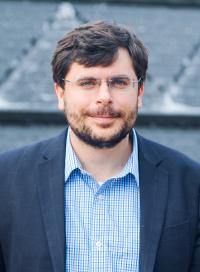Oct 7 2014
A $470,350 award from the National Science Foundation will support research at Indiana University-Purdue University Indianapolis (IUPUI) to gain a better understanding of how proteins form groups or clusters within cells in the living body. Abnormal protein grouping is known to be associated with cancer and with heart arrhythmias, but scant knowledge exists about how proteins group.
 Steve Pressé is an assistant professor of physics in the School of Science at Indiana University-Purdue University Indianapolis. Credit: School of Science at Indiana University-Purdue University Indianapolis
Steve Pressé is an assistant professor of physics in the School of Science at Indiana University-Purdue University Indianapolis. Credit: School of Science at Indiana University-Purdue University Indianapolis
"We will be conducting the first truly systematic investigation into how proteins assemble to determine the group makeup as well as the processes by which they assemble," said biophysicist Steve Pressé, assistant professor of physics in the School of Science, the principal investigator of the NSF grant. "Our goal is to gain an understanding of what is normal so we can also learn what is not normal. Ultimately, preventing or correcting abnormal grouping will require knowledge of both."
Proteins are complex molecules that do much of the cell's work and are required for the structure, function, and regulation of the body's tissues and organs. They are difficult to visualize, even with modern imaging techniques. Because of their small size, super-resolution methods involving the tagging of proteins with special florescent dyes are used to study proteins. These dyes behave like tiny light bulbs that allow scientists to precisely locate the tagged protein in live cells. However, the tagged proteins may be packed so tightly in a group that all the light bulbs may be crammed within space the size of a single pixel on a super-resolution image.
While this imaging technique allows the visualization of structures down to 0.01% of the width of a human hair (about 20 nanometers), it remains difficult to count proteins in a group, Pressé explains, because, in the cell's complex environment, these light bulbs flicker.
With the assistance of an IUPUI physics doctoral student and a post-doctoral fellow, Pressé will spend the next three years tackling the challenging problem of translating images obtained by superresolution imaging into computer code to provide critical data on how proteins assemble into groups. They anticipate that their cross-disciplinary project will yield methods that will have broad applicability to other mysteries within the cells of the human body.